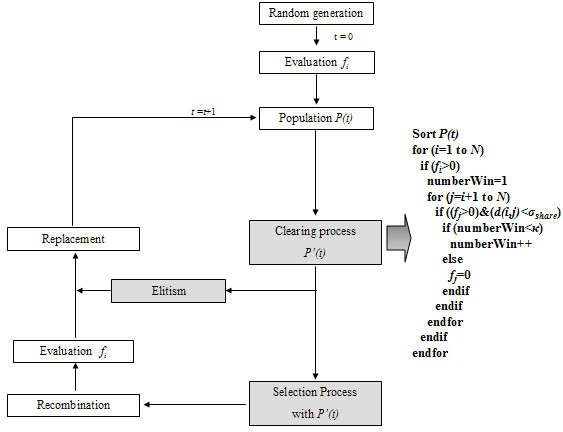|
Clearing method is based on the
concept of limited resources to eliminate rivalry
among different solutions. In nature life available
resources for each species are limited and different
from other species. This permits biodiversity as
rivalry between individuals of different species
decreases allowing cohabitation in the same
geographical area (it is possible coexistence and
survival of so different animals such as the lion
and the ant as they do not need to fight for the
same resources).
Following these principles, the
clearing limits the selective pressure by modifying
the landscape of the population before making a
selection. The original P(t) population (with
size N) is modified to form another
P�(t) population (with size N�) for reproduction.
Clearing and selection: The process of forming the
population P�(t) starts by putting in order
from higher to lower quality, the solutions of the
original population P(t). The first solution
is selected and goes directly to the population
P�(t). This first solution is called dominant
as there is no better solution inside the
population. Afterwards, each solution of the original P(t) population
is compared with the selected solution, and the solutions
which belong to a same niche are
obtained (those solutions whose distance to the selected
one is
shorter than a radius (σshare)).
The k best solutions
called winners (those with higher quality) are saved
whereas the rest are assigned a null quality. This
way, the competition inside the niche is limited
leaving k solutions as survivors and the
rest are not given any hope to survive in the selection
process.
From this moment
the process becomes iterative selecting the
following solution of the ordering whose quality is
different from zero. The iterative process finishes when all
solutions pending to be selected in P(t) have
zero quality. Reproduction is performed over
the solutions of P�(t).
Elitism:
The solutions from the P�(t) population with a quality higher than the average of the
original quality in the population before the
clearing process, are selected to survive and pass
directly to the following generation. The rest of
positions are filled with the best children
obtained.
This process is
shown in the following flowchart:

|

